Here’s a hard truth: improving both brand and customer experience together can drive up to 3.5x revenue growth while boosting retention and loyalty.
But most businesses never see that growth. Why? Because customer insights are scattered across tools, survey response rates are abysmal, and teams spend more time stitching data together than actually fixing what’s broken. One bad interaction, and the customer is gone.
That’s where customer experience management software changes the game. The right tool doesn’t just capture feedback—it connects the dots, predicts churn before it happens, and gives you the clarity to act fast. Think of it as your growth radar for customer happiness.
In this guide, you’ll find:
- A quick comparison of the top CXM tools in 2025 (pricing, ratings, highlights).
- A deep dive into 22 platforms with features, pros/cons, and real user reviews.
- A buyer’s playbook to avoid budget traps, messy integrations, and tools your team won’t adopt.
Simple, practical, and built for professionals who want results—not just dashboards.
Read on to find out!
What is Customer Experience Management Software?
CX management platforms are the driving force behind creating exceptional experiences that turn customers into loyal advocates. It’s a suite of tools designed to help businesses understand their customers, track their journeys, and ensure every interaction is positive and memorable.
Customer experience management software lets you listen closely to their feedback, see where they might stumble, and even anticipate their needs before they arise.
Leverage Customer Experience Management Software For:
- Gathering feedback across every channel.
- Observing how customers interact with your brand at each touchpoint.
- Using data to predict what your customers might want or need next.
- Tracking crucial customer satisfaction and loyalty metrics to ensure your efforts drive positive results.
Short on time? Let’s start with a quick comparison
| Tool | Best For | Starting Price | Highlight | User Rating* |
|---|---|---|---|---|
| Qualaroo | Real-time behavioral insights | Offers a forever-free plan with all premium features. Starts at $19.99/month | Nudges™ with AI-powered sentiment analysis | 4.7/5 (Capterra) |
| ProProfs Survey Maker | Surveys, quizzes, polls | Forever-free plan available. Paid starts at $19.99/mo | 100k+ ready-to-use questions & 100+ templates | 4.8/5 (Capterra) |
| ProProfs Chat | Live chat & chatbot automation | $19.99/mo | AI chatbots with 24×7 support | 4.8/5 (Capterra) |
| Medallia | Predictive CX insights | Custom | Strong text & sentiment analysis | 4.5/5 (G2) |
| Qualtrics | Enterprise feedback & insights | Custom | Predictive intelligence engine | 4.4/5 (G2) |
| SurveySparrow | Conversational surveys | $19/mo | Chat-like surveys for higher response rates | 4.4/5 (G2) |
| Survicate | Website & app surveys | $79/mo | Targeted survey triggers & integrations | 4.6/5 (G2) |
| ProProfs Knowledge Base | Self-service help centers | Forever-free plan available. Paid starts at $49/author/mo | 100+ templates, 90+ languages supported | 4.7/5 (Capterra) |
| ProProfs Help Desk | Ticket management & automation | $19.99/user/mo | Shared inbox & advanced reporting | 4.9/5 (Capterra) |
| Hiver | Gmail-based helpdesk | $19/user/mo | Works seamlessly inside Gmail | 4.6/5 (G2) |
| Zendesk | Omnichannel ticketing | $19/agent/mo | Wide range of integrations | 4.3/5 (G2) |
| LiveAgent | Multi-channel helpdesk | $15/agent/mo | Voice, chat, email & social | 4.5/5 (G2) |
| Genesys | Contact center & AI bots | $75/user/mo | Predictive routing & AI coaching | 4.4/5 (G2) |
| Intercom | Customer messaging & engagement | $39/seat/mo | Unified inbox with proactive messaging | 4.5/5 (Capterra) |
| Picreel | On-site retargeting & surveys | $9.99/mo | Exit-intent & popup overlays | 4.9/5 (Capterra) |
| HubSpot | All-in-one customer platform | $9/mo/seat | 360° customer view | 4.4/5 (G2) |
| BIGContacts | SMB pipeline management | $9.99/mo | Simple sales & CX automation | 4.5/5 (G2) |
| Birdeye | Multi-location review management | Custom | AI-powered review responses | 4.7/5 (G2 & Capterra) |
| Adobe Experience Manager | Omnichannel content management | Custom | AI-driven personalization | 4.2/5 (G2) |
| OpenText Experience Cloud | Digital CX suite | Custom | Unified access & AI agent assistance | 4.4/5 (Gartner) |
| SAS Customer Intelligence 360 | Journey mapping & insights | Custom | Advanced visualization dashboards | 4.3/5 (G2) |
| UserTesting | Usability & research | Custom | Remote moderated & unmoderated testing | 4.5/5 (G2) |
Best Customer Experience Management Software & Tools
Your customers deserve the best, right? So, I have gathered 22 CX Management platforms to help you understand your audiences, delight them, and build lasting relationships. Here’s a deep dive into the 22 customer experience management software to help you understand your audiences, delight them, and build lasting relationships. These tools are not ranked in any particular order and have been put in distinct categories for your convenience.
- Feedback & Voice of Customer Tools
- Content & Knowledge Management
- Customer Service & Support Tools
- Customer Engagement, CRM & Marketing
- Digital Experience Platforms
- Customer Analytics & Insights
- User Experience & Testing
Feedback & Voice of Customer Tools:
Whether it’s an exit survey on your site, an in-app nudge during checkout, or a quick NPS question, these tools help you uncover the “why” behind customer behavior and turn silence into insights:
1. Qualaroo
Qualaroo has always been my go-to CX management tool. The tool makes it super easy to gather real-time feedback and analyze it with powerful AI. Qualaroo’s Nudges™ ask the right questions at the right time.
It uses IBM Watson’s sentiment analysis to analyze open-ended responses and uncover customer sentiment and emotions. This means you can identify disappointed users on the spot, pinpoint issues, and address issues before they snowball—all leading to a smoother, happier customer experience.
Best for: Real-time behavioral insights, customer sentiment analysis, surveying, and feedback.
Pros:
- Deploys within a few minutes without help from developers.
- Offers professional templates for different surveys like CSAT, NPS, CES, Exit-intent, and more.
- Helps you gather qualitative, quantitative, and contextual feedback using Survey Nudges™.
- Customizes the templates as per your branding.
- Offers advanced targeting options and survey triggers to ask the right questions to the right people at the right time.
- Helps you collect contextual feedback using Branching and Skip Logic features.
- Easily integrates with tools like HubSpot, MailChimp, Salesforce, and Google Analytics.
Cons:
- No downloadable or on-premise version.
- The dark user interface option is not yet available.
Pricing: Starts at $19.99/month. Forever free version available with all the premium features.
User Rating: 4.7/5 (Capterra)
User Review: “The branching technology on surveys makes it easy to target customers based on their behaviour. Also the design API meant it was easy to brand our overlays in a way that suited our business. The on-board process was great and the team worked hard to create a specific integration to meet our business needs.” – Aaron, Web Analyst (Capterra)
2. ProProfs Survey Maker
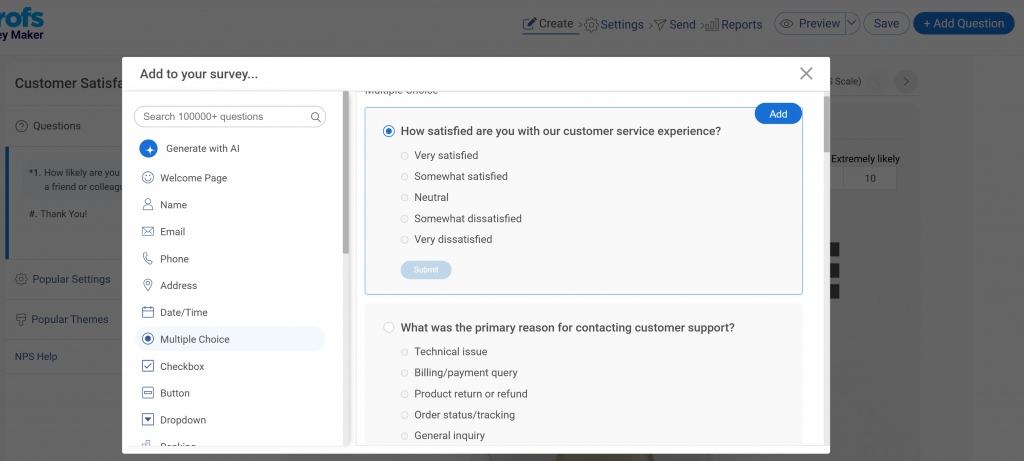
ProProfs Survey Maker & Qualaroo come bundled together. I have always leveraged its multiple interactive means of collecting customer feedback, such as surveys, quizzes, polls, tests, web forms, and assessments.
You can even add a feedback sidebar on your website to elicit unprompted feedback about the visitors’ experience. This customer experience software provides a detailed reporting section to track real-time survey performance. You can analyze each response, monitor completion rate, and track quiz scores, among other metrics.
Best for: Automatic analytics, presentation-ready reports, scored quizzes, and feedback sidebar.
Pros:
- Offers an AI survey builder to create interactive questionnaires, quizzes, polls, and surveys.
- Provides 100+ templates to support faster survey deployment.
- Offers 100k+ ready-to-use questions for you to use in surveys to collect rich feedback.
- Comes with 15+ question types.
- Lets you publish surveys on mobile apps and websites.
- Offers a feedback sidebar that collects input without disrupting the user experience.
- Integrates with tools like MailChimp, Salesforce, and more.
Cons:
- No downloadable or on-premise version.
- A dark viewing mode is not available.
Pricing: Starts at $19.99/month. Forever free plan available with all the premium features.
User Rating: 4.8/5 (Capterra)User Review: “With ProProfs Survey Maker, survey building is easy.Comes with great forms automation features. It makes it easy to gauge customer experience. Customizing survey forms is easy and I like that it comes with premade survey forms” – Simon, Customer Care Rep (Capterra)
3. Sprinklr
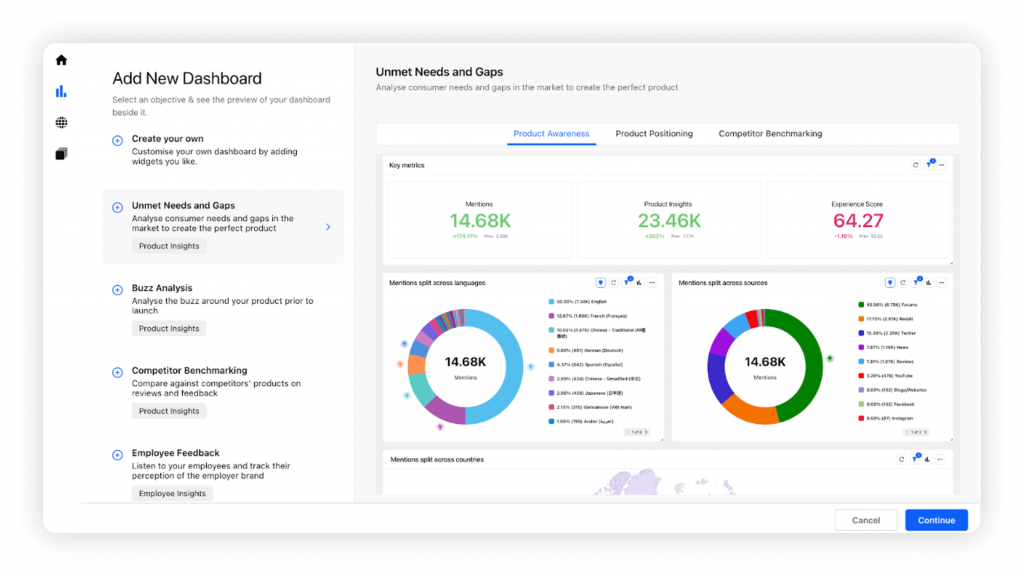
Sprinklr is an AI-powered customer experience management platform. It helps businesses deliver personalized experiences across multiple digital channels by consolidating social media, messaging, live chat, SMS, and email into one unified platform.
The tool provides advanced AI-driven insights to understand customer sentiment, track brand reputation, and streamline engagement. With its omnichannel capabilities, companies can manage customer conversations, automate workflows, and monitor performance analytics in real time.
Best for: Enterprise-grade customer experience management, AI-powered insights, and omnichannel engagement.
Pros:
- Unifies customer interactions across 30+ digital and social channels.
- Offers powerful AI-driven sentiment and intent analysis.
- Provides workflow automation for faster customer support resolutions.
- Enables social listening to track brand reputation and competitor activity.
- Supports real-time analytics dashboards with customizable reporting.
- Integrates with enterprise tools like Salesforce, Microsoft Teams, and Slack.
Cons:
- Complex setup process with a steep learning curve for new users.
- Premium pricing may not be suitable for small businesses.
Pricing: Custom pricing available on request. Sprinklr tailors its plans based on enterprise needs and scale.
User Rating: 4.2/5 (G2)
User Review: “The interface is feature-packed but not always intuitive, so onboarding takes time. Setting up automation rules or workflows often requires technical support, and even small configuration changes can feel complex. We’ve also experienced occasional delays in social data syncs.” — Shruti D., Social Media Manager (G2)
4. Medallia
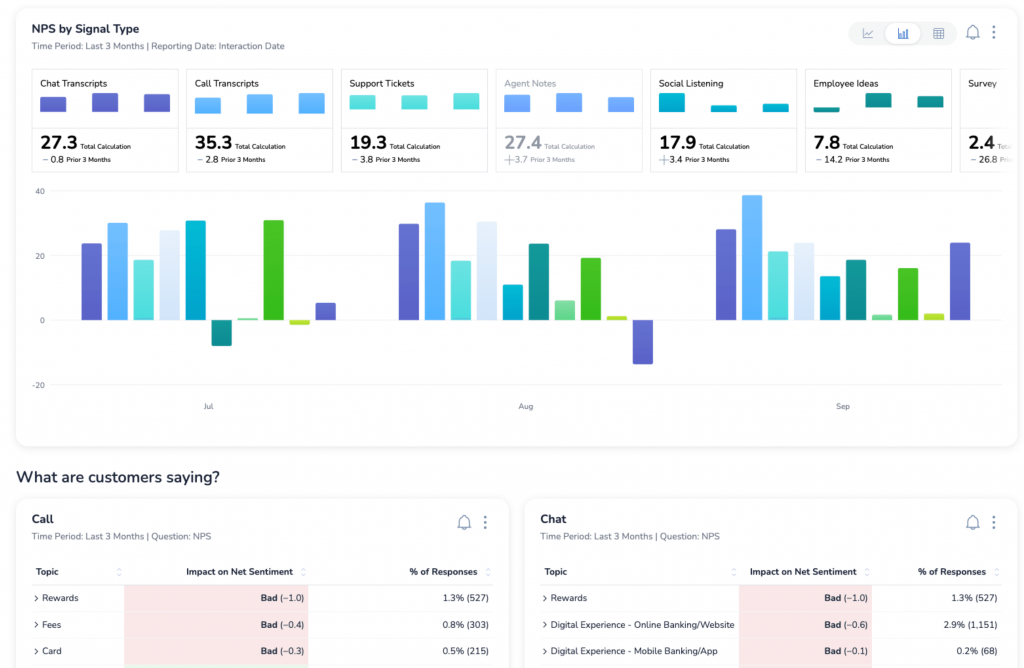
Medallia is one of the top customer experience survey tools. It analyzes feedback from multiple channels to predict customer behavior and needs, detect unhappy customers at risk of churn, and suggest appropriate actions based on those insights.
I met a CX lead who said they used to discover unhappy customers only when churn reports landed—it was too late to fix anything. With Medallia, they started spotting at-risk customers early by analyzing survey responses and social feedback in real time.
Best for: Predicting customer needs, automating customer service workflows, multi-channel deployment, and NPS surveys.
Pros:
- Helps you flag reviews based on CX scores, timings, keywords, etc.
- Facilitates performance benchmarking and competitive analysis.
- Helps review comments and feedback from open-ended survey responses using Text Analysis.
- Provides access to manage controls in the reporting section.
- Offers a word-cloud engine for feedback analysis
- Tracks customer complaints easily
Cons:
- Word-cloud may provide inconsistent results.
Pricing: Available on request.
User Rating: 4.5/5 (G2)User Review: “The platform is very adaptable to information visualization needs. One of the areas of opportunity I consider is the lack of more comprehensive dashboards for the Ad-hocs.”– Rita B., VoC Manager (G2)
5. Qualtrics
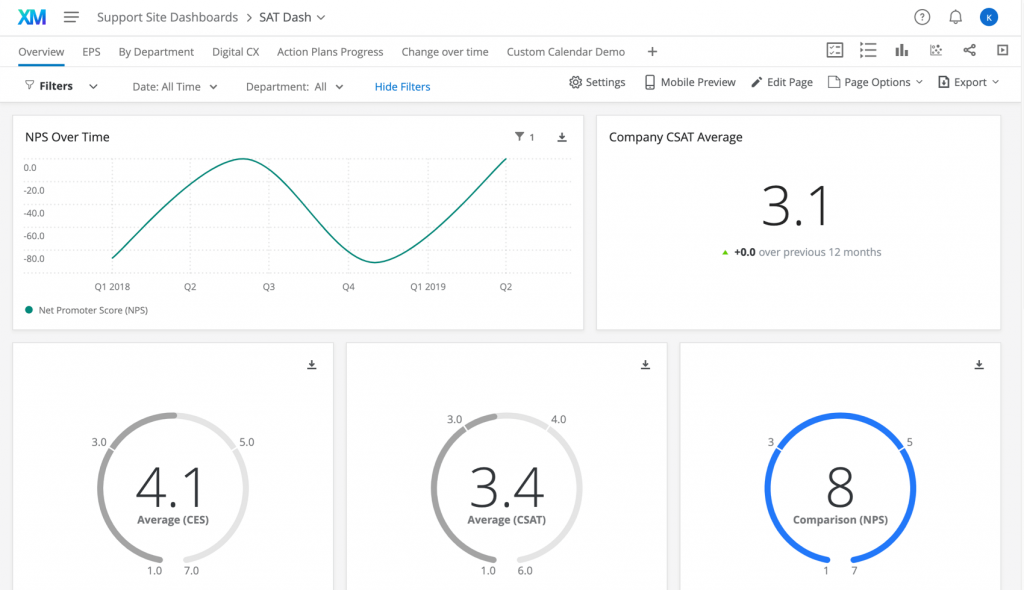
I spoke with a marketing director who said, “We run campaigns, but we don’t know which ones actually make customers happy.” They turned to Qualtrics and started running CSAT and NPS surveys tied directly to customer journeys.
These are combined with automated content and promotion delivery to boost conversions and the customer experience. Qualtrics helps you listen to your customers’ voices and fix any broken experiences to increase spending and improve customer loyalty.
Best for: Text analytics, real-time service alerts, natural language processing, automated content, and ad delivery.
Pros:
- Lets you create multiple types of surveys like CSAT, NPS, and CES.
- Provides conversation analytics to monitor and analyze customer interactions and activities using Qualtrics Connect.
- Sends alerts when specific nuances are detected in the feedback using XM Discover.
- Comes with an ExpertReview tool that suggests questions and design recommendations.
- Analyzes customer emotions using Sentiment Analysis.
- Monitors and analyzes data reports using Predictive Intelligence.
Cons:
- Needs a more interactive UI.
- Responses do not attach to individual threads.
Pricing: Available on request.
User Rating: 4.4/5 (G2)
User Review: “There are some limitations to what the Dashboards can look like, and I often find myself putting them outside of Qualtrics to get the look and feel that my executives are looking for. But they do give you all the data that you need. Also there is a solution for calculating Response Rate but it isn’t incredibly straight forward.” – Thomas W., Sr. CX Manager (G2)
6. SurveySparrow
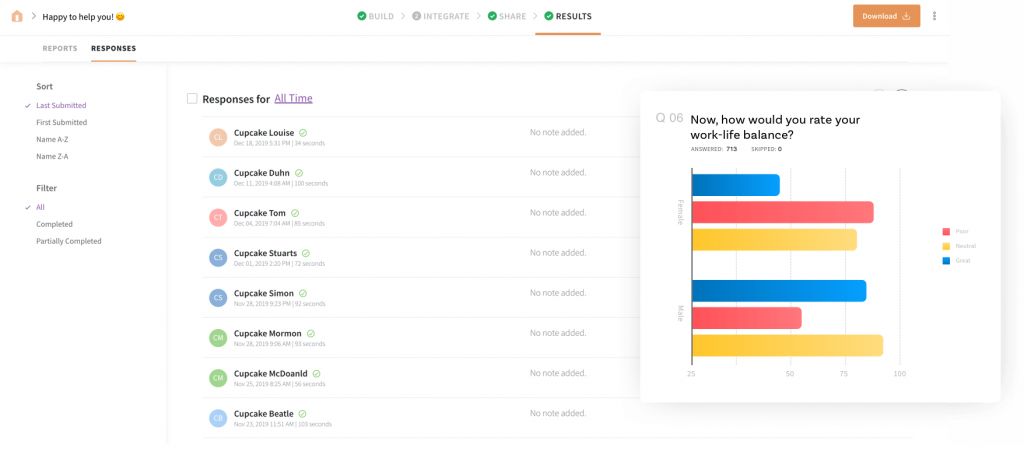
I remember a SaaS founder frustrated with their survey response rates—customers just weren’t engaging. Switching to SurveySparrow changed that. It takes customer feedback and makes it feel like a conversation instead of a boring form.
Its chat-like surveys increase completion rates and give you better-quality responses. For businesses struggling with low survey engagement, this tool helps you gather the voice of your customer in a more natural way.
Best for: Conversational surveys.
Pros:
- Chat-style surveys that feel more engaging and boost response rates
- Easy to design and customize without technical know-how
- Automation for recurring surveys and NPS programs
- Multi-channel distribution (web, email, SMS, social)
Cons:
- Fewer advanced analytics compared to enterprise-level platforms
- Limited offline survey capability
Pricing: Starts at $19/month.
User Rating: 4.4/5 (G2)User Review:“SurveySparrow’s conversational interface makes surveys feel like natural chats, boosting engagement and response rates. SurveySparrow can get pricey for small teams, especially on higher plans with advanced features. Some users also report limited customization in lower tiers and occasional lags in real-time analytics or reporting. Integration depth could be improved for niche tools.”– Emmanuel A., Sales And Marketing Specialist (G2)
7. Survicate
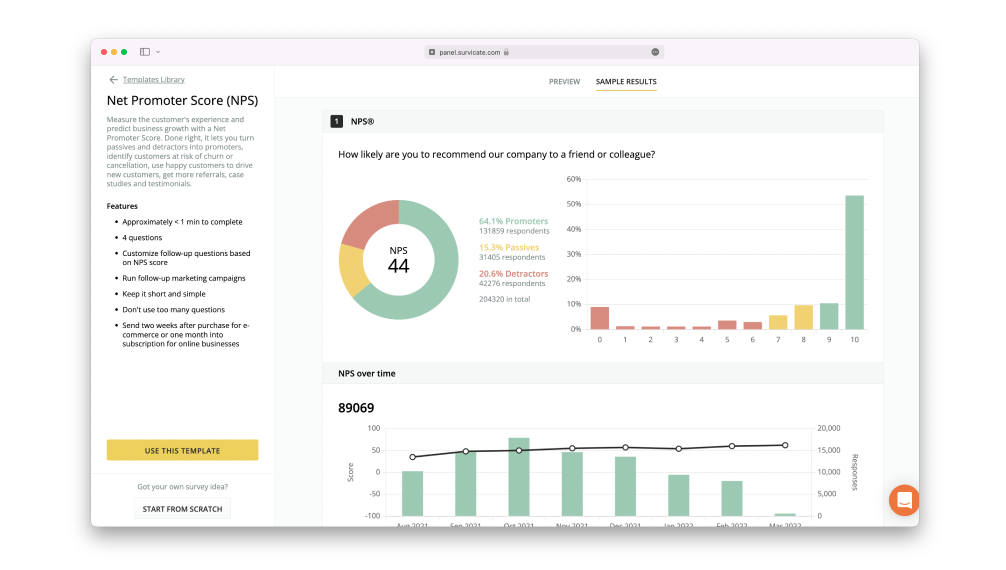
A product manager once told me, “We’re bleeding users during onboarding, but we don’t know why.” They dropped Survicate into their app, and within days, the picture was clear—most people bailed at step two because the instructions were confusing. Fixing that one step improved retention instantly. That’s the power of asking the right question at the right time.
Best for: Website & app surveys
Pros:
- Smart targeting to launch contextual surveys in-app or on-site
- Built-in templates for NPS, CSAT, CES, and product feedback
- Seamless integrations with CRMs and analytics tools
- Clean, modern builder with quick setup
Cons:
- Price can feel steep for smaller teams
- Reporting dashboards have limited customization
Pricing: Starts at $79/month
User Rating: 4.6/5 (G2)User Review: “While Survicate is strong in its core survey features, I find the AI capabilities could be more in-depth. I wish the AI was more of a partner in the survey creation process. For instance, it would be incredibly helpful if AI could assist in drafting questions, offering suggestions to eliminate biased wording, and providing a deeper analysis of potential survey outcomes before launch.”– Johnny P., Senior Product Designer (G2)
Content & Knowledge Management:
From FAQs and guides to tutorials and tooltips, content management tools reduce ticket volume, speed up onboarding, and keep both customers and support teams happier:
8. ProProfs Knowledge Base
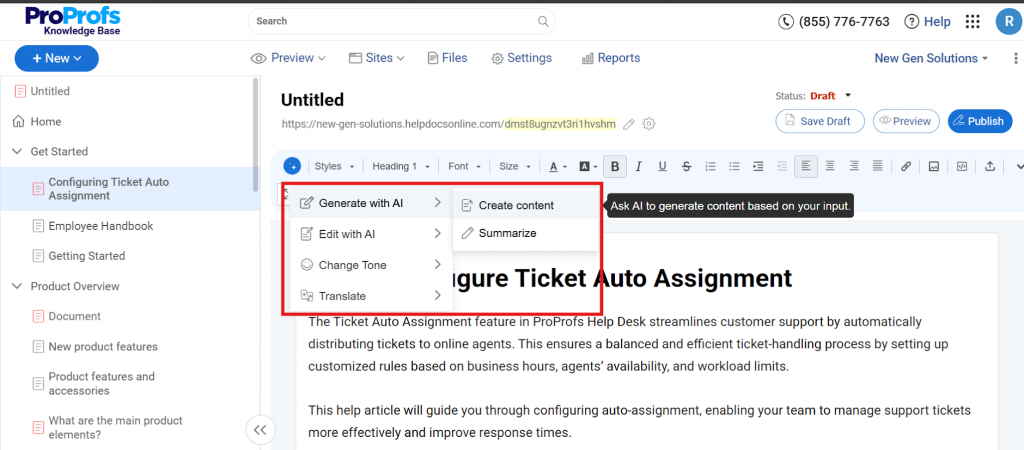
I once met a support head who said their team was swamped with the same “How do I…?” questions over and over. Customers were frustrated, and agents were burned out. They rolled out a ProProfs Knowledge Base with easy FAQs, guides, and videos.
Within weeks, repetitive tickets dropped dramatically because customers started helping themselves. Support stopped being a bottleneck, and the team could finally focus on bigger problems. Other features include guided tooltips, mobile responsive design, a comment and feedback section, and accessibility control.
Best for: Scaling customer support and enhancing team collaboration.
Pros:
- Helps create beautiful pages for your audience to engage with using 25+ page templates.
- Lets you add videos and images to your knowledge base to make your articles more interactive.
- Guides users on complicated features and explains technical terms with tooltips and popups.
- Provides a Google-like search experience to your visitors to help them scan better.
- Enables assigning multiple authors and eliminates duplication by showing everyone’s input.
- Caters to a global audience with the support of 90+ languages.
- Redirects users to the correct URL through the URL redirection feature.
Cons:
- There is no downloadable or on-premise version.
- No dark user interface option is available.
- Unlike the paid one, the free plan doesn’t support a dedicated account manager.
Pricing: Starts at $49/author/month. Forever free plan available with all the premium features.
User Rating: 4.7/5 (Capterra)User Review: “I was receiving a lot of complaints regarding my call support as customers had to wait on IVR for long time. So, I wanted to set up a help site for my customers and I came across ProProfs Knowledgebase. It was so simple to set up the site and I was able to use videos & images to visualize the help articles. ProProfs rules!” – Jacqueline, Founder (Capterra)
Customer Service & Support Tools:
These tools help teams streamline ticket management, cut response times, and turn frustrated users into loyal advocates. Here are the best customer support tools for awesome CXM:
9. ProProfs Help Desk

After moving to ProProfs Help Desk, everything landed in one shared inbox. Suddenly, tickets were organized, agents knew exactly who was working on what, and customers stopped falling through the cracks.
It is SaaS-based customer experience management software that supports ticketing and a knowledge base to help you quickly support your customers. Other features include setting ticket SLAs, monitoring overdue alerts, creating child tickets, and sending surveys to collect feedback and assess the performance of your support channels.
Best for: Streamlining ticket management and improving agent efficiency
Pros:
- Helps track incoming support tickets and manage them through a unified dashboard.
- Lets you customize agent availability settings and calculate your staff’s response time.
- Enables defining permissions and assigning roles to agents such as admin, manager, and staff.
- Lets you add private notes to tickets to relay additional information to agents.
- Helps connect your social media channels to manage customer requests seamlessly.
- Simplifies query resolution by sending automated responses to customer tickets.
- Tracks agent performance and customer satisfaction with advanced reports and analytics.
Cons:
- The dark user interface option is not available.
- No dedicated account manager in the free plan, unlike the paid one.
Pricing: Starts at $19.99/user/month. A forever free plan with all the premium features is available.
User Rating: 4.9/5 (Capterra)
User Review: “Prior to using ProProfs Help Desk software, everything was a big mess. Tickets remained pending for weeks or sometimes, even months. However, with solid ticket organization features and statuses, managers can track which tickets need the utmost attention.” – Verified Reviewer (Capterra)
10. Hiver
A customer success manager once told me, “Our team lives in Gmail, but managing support there is a nightmare.” That’s where Hiver shined. It is a multi-channel helpdesk tool built specifically for teams on Google Workspace.
The best part about Hiver is that it works inside Gmail, an interface most teams already know. It enables businesses to offer quick, efficient, and intuitive customer support without denting their budget. With Hiver, your teams can tackle customer queries at scale and gain deep insights into the quality of your support.
Best for: Email Management, multi-channel support, and collaboration.
Pros:
- Allows you to automatically assign emails to users with a shared inbox using Round Robin Assignment.
- Effectively helps you manage your incoming queries.
- Enhances team collaboration with features like Notes and @mentions for internal communication about a ticket without sending more emails.
- Comes with automation capabilities to optimize your operations.
- Facilitates an in-depth analysis of your team’s workload and performance.
- Integrates with popular apps like Asana, JIRA, Salesforce, Slack, and Zapier to enhance productivity.
Cons:
- Only for businesses using Google Workspace.
Pricing: Starts at $19/user/month.
User Rating: 4.6/5 (G2)
User Review: “Hiver makes it much easier to stay organized and collaborate as a team. There are a few challenges. First, being forced to use Gmail’s conversation view isn’t ideal—it can be confusing when managing multiple threads. Also, all Hiver notifications go to the bell icon instead of email, unless you manually create notification rules, which adds unnecessary setup.” – Chase E., Manager of HR Operations
11. ZenDesk
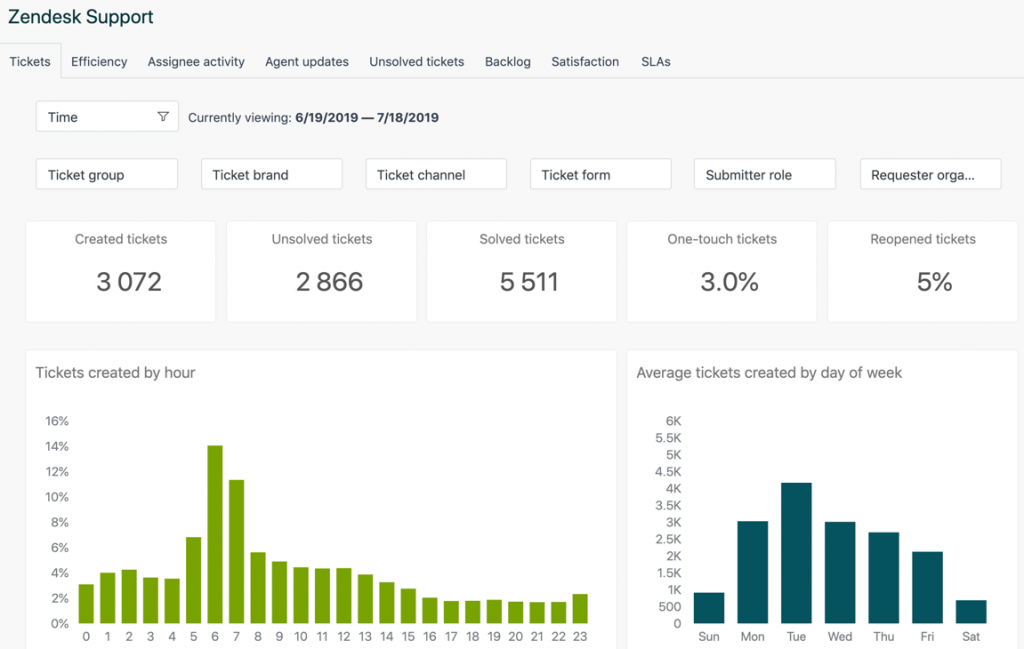
I once heard a support lead joke, “We had five tools open just to answer one customer.” Zendesk solved that for them. It brought email, chat, social media, and even community forums into one place.
It facilitates efficient support and allows businesses to gain valuable insights into user behavior and sentiment. It also includes native features for automated responses and analytics. Moreover, any purpose-specific apps you use for these functions likely offer a ZenDesk integration.
Best for: Multi-channel communication and easy response management.
Pros:
- Reduces incoming service requests by building a knowledge base.
- Improves customer experience by analyzing how they interact with your business.
- Enables customers to get together and participate by creating community forums.
- Helps make data-driven decisions by leveraging built-in analytics and reports.
- Enables creating personalized and interactive messages using built-in conversation tools.
- Integrates with popular third-party applications and elevates your customer support experience.
Cons:
- Requires individual licenses to add new agents.
- The dashboard can be slightly intimidating for new users.
Pricing: Starts from $19/agent/month, billed annually.
User Rating: 4.3/5 (G2)
User Review: “While Zendesk Support Suite is a robust and reliable platform, there are a few areas that could be improved. At times, the admin settings can feel a bit complex or unintuitive, especially when setting up advanced workflows or automation rules—it takes some time to fully understand and configure them correctly.” – Supriyo M., Support Analyst (G2)
12. LiveAgent
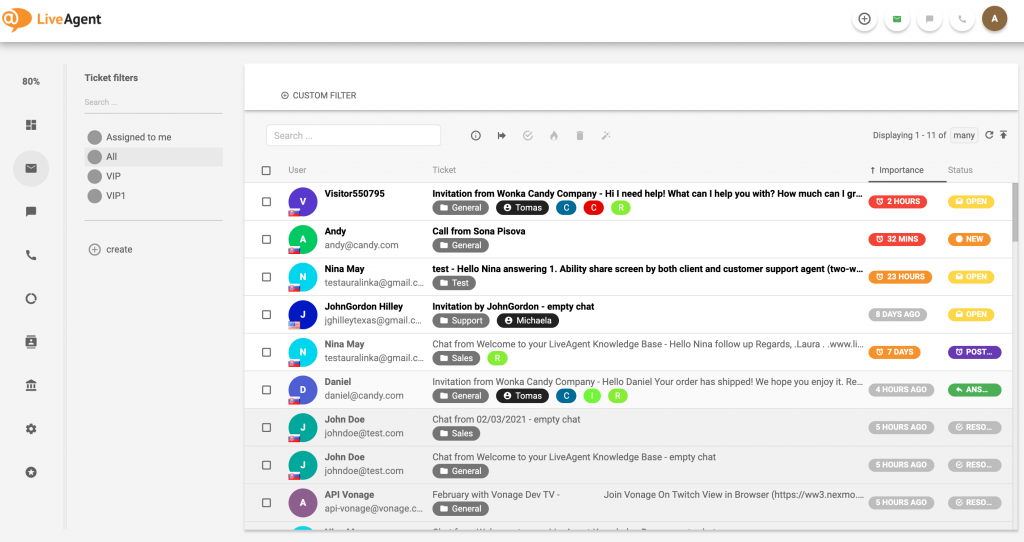
A mid-size e-commerce founder told me they used to lose customers who waited too long on chat. After adding LiveAgent, their team could not only respond faster but also reach out proactively.
It is a general-use helpdesk platform that enables live support across various channels, including voice, text, and social media. It also provides the tools to quickly create customer portals, ticketing systems, and self-service resources. LiveAgent supports many integrations, enabling you to integrate these functionalities into the tool.
Best for: Creating forums and internal & multi-knowledge base.
Pros:
- Automatically lets you distribute tickets to your agents for optimal workloads.
- Lets you copy and paste images into your tickets for better engagement.
- Helps invite website visitors to chat with you while browsing your website.
- Allows your customers to request automatic callbacks whenever they want.
- Routes customer calls based on priority through call routing.
- Helps you respond to Instagram comments and mentions from your dashboard.
Cons:
- Cannot use multiple canned messages in one ticket.
- Cannot move the filters up or down.
Pricing: Starts from $15/agent/month.
User Rating: 4.5/5 (G2)User Review:“A major advantage of the system is how quickly and effortlessly it can be implemented. One area that could be enhanced is the integration with the WhatsApp Business API, especially to enable better interaction between LiveAgent’s internal triggers and WhatsApp message delivery.”– Jorge N., CEO (G2)
13. Genesys
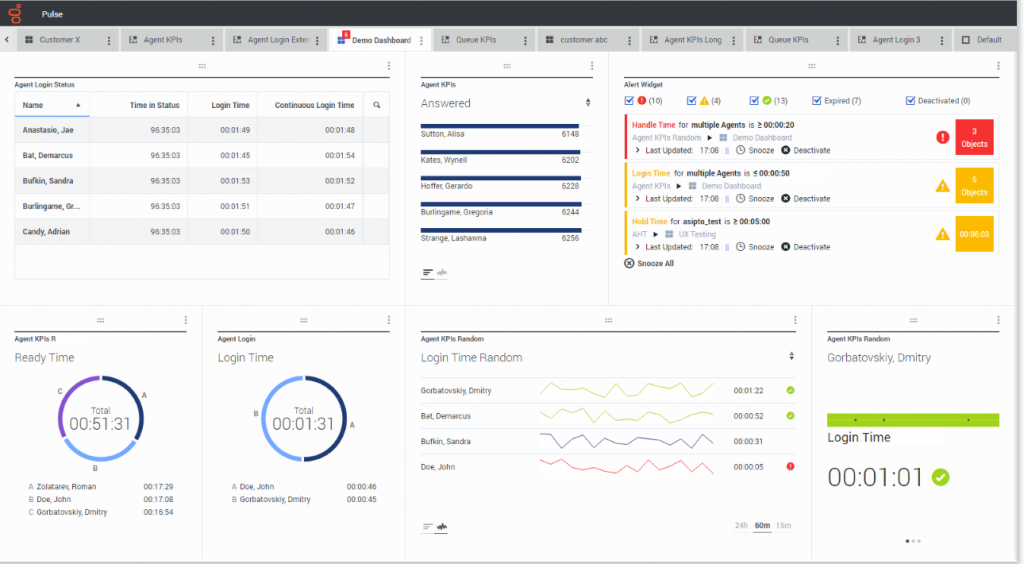
I met a call center manager who said, “Our agents spend half their time guessing which call to take next.” After moving to Genesys, predictive routing took the guesswork out. Their advanced AI bots are indeed a standout feature, capable of understanding and engaging in natural language conversations via both text and voice.
Genesys also includes machine learning-powered agent coaching, providing agents with real-time feedback and insights.
Best for: Digital customer engagement and customer self-service.
Pros:
- Lets you host fluid conversations across all platforms with the help of intuitive design.
- Resolves customer issues much faster with speech-enabled IVR.
- Simplifies your customer journeys with the help of conversational voice bots that work on all channels.
- Helps your customers 24×7 and handle complaints effectively with AI-powered chatbots.
- Allows your customers to opt-in for callbacks when they need support.
- Routes your customers’ interaction to the best possible agent with predictive routing.
Cons:
- The mobile version of Genesys Cloud needs significant improvements.
- Cannot sort agent statuses.
Pricing: Starts from $75/user/month, billed annually.
User Rating: 4.4/5 (G2)User Review: “It’s very simple to get used to, even for someone who is not very tech savvy. Sometimes there is a bit of a delay when logging in. Also, the reporting dashboard could be made more flexible. And honestly need to have an option to use as in Dark mode which was previously present.”– Bikram A., Senior Customer Experience Manager (G2)
Customer Engagement, CRM & Marketing:
The right tools help you retarget visitors before they leave, centralize customer data for a 360° view, and nurture leads into loyal customers. Here are some platforms that turn everyday interactions into long-term growth:
14. Intercom

One of the most versatile customer engagement platforms I’ve used is Intercom, which offers live chat, AI-powered support, and customer messaging all in one place. It helps you engage visitors in real time, deliver personalized onboarding, and provide fast self-serve support through chatbots and help centers.
You can segment audiences, automate follow-ups, and guide users at key moments in their journey. With its unified inbox, your support, sales, and marketing teams can collaborate seamlessly to improve the customer experience.
Best for: Live chat, AI chatbots, customer messaging, onboarding, support automation
Pros:
- Offers AI-powered chatbots to reduce support load and resolve common queries instantly.
- Unified inbox helps streamline communication across teams and channels.
- Supports targeted, behavior-based in-app and email messages.
- Integrates customer data for personalized conversations and user segmentation.
- Provides customizable workflows and automation for proactive support.
- Offers a no-code help center builder to improve self-service.
Cons:
- Can get expensive for growing teams as usage scales.
- Some advanced features require higher-tier plans.
Pricing: Starts from $39/month per seat. Custom pricing available for advanced features.
User Rating: 4.5/5 (Capterra)
User Review: “I like the AI FIN module which is faster in processing resolutions to customers. Intercom requires a lot of time to deploy the solution fully and does not offer free WhatsApp integrations like other solutions in the market” – Sheila Olivia N., International Relations Officer (Capterra)
15. HubSpot
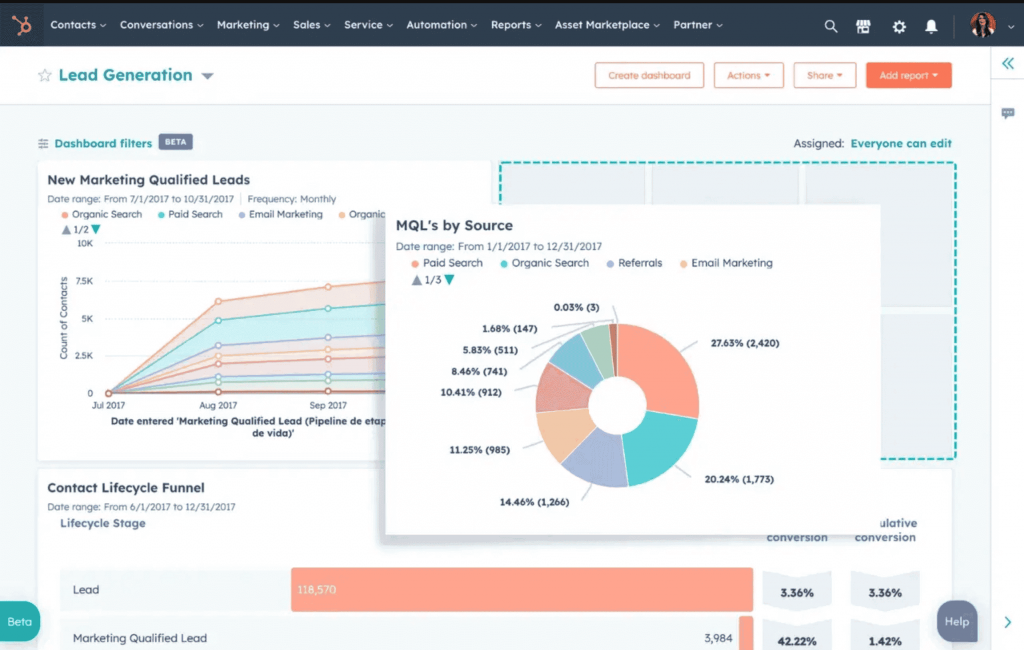
I talked to a founder who said, “We’re juggling three tools just to track customer conversations.” HubSpot solved that by bringing sales, marketing, and service into one platform.
It empowers businesses to efficiently manage and elevate customer experience through Sales, Service, Marketing, and Operation functionalities. A key strength of HubSpot lies in its ability to centralize customer data, providing a 360-degree view of each individual.
Best for: Contact and sales pipeline management
Pros:
- Provides real-time customer support and engagement through live chat and conversational bots.
- Streamlines email campaigns with personalized content and automated workflows.
- Centralizes customer data and interactions for efficient support management through CRM integration with support tickets.
- Enables monitoring and engagement with customers across various social platforms through social media management tools.
- Gathers valuable insights to understand customer sentiment and identify areas for improvement via customer feedback and surveys.
Cons:
- Expensive for smaller businesses.
- Steep learning curve.
Pricing: Starts at $9/seat/month, billed annually. Free plans available (limited features).
User Rating: 4.4/5 (G2)User Review:“What I like most about HubSpot Service Hub is how everything is centralized in one place. While HubSpot Service Hub is great overall, some features feel limited unless you’re on a higher-tier plan. Also, the reporting tools could be more flexible when it comes to customizing dashboards for specific team needs.”– Fahd R., Customer Experience Lead (G2)
16. BIGContacts
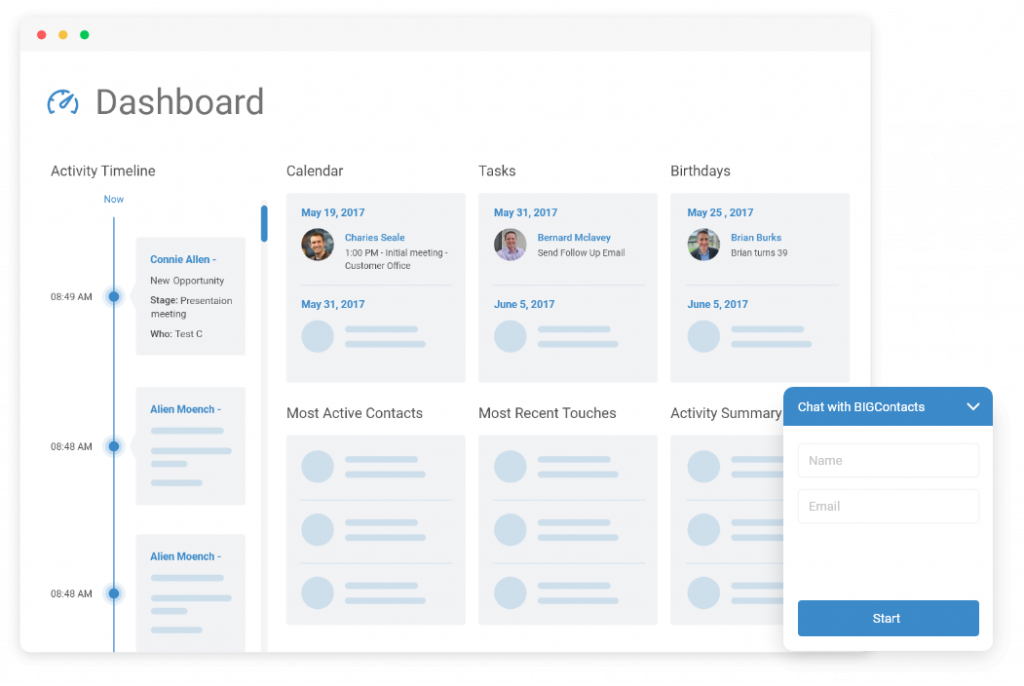
I’ve been using BIGContacts for the longest time, and is the perfect customer experience management platform for small businesses to manage prospect lists and sales pipelines. You can import all customer communication in one place and track contacts by activity, opportunity, stage, last contact, and other custom fields.
It also lets you automate tasks, create marketing campaigns, identify opportunities, and create detailed reports to nurture prospects into customers.
Best for: Organizing customers and prospects and automating marketing campaigns.
Pros:
- Track and manage sales opportunities through a detailed sales pipeline.
- Pull in support tickets from your help desk tool to effectively manage customer complaints.
- Segment and prioritize higher-value customers and elevate their experience.
- Design and manage personalized email marketing campaigns to delight your customers.
- Set up activity reminders, automate tasks, and create diverse workflows.
- Track team members and business performance through powerful analytics and reports.
Cons:
- No dedicated account manager for the free plan, unlike the paid one.
- There is no downloadable or on-premise version.
Pricing: Starts from $9.99/month. Free plan available (up to 100 contacts).
User Rating: 4.5/5 (G2)
User Review: “BigContacts offers a visual sales pipeline that gives a quick peek into all contacts and their respective stages in the sales cycle, along with other important information. The best part is we can also drag and drop deals to build a custom pipeline that is in sync with the sales cycle.” – Sara A., Outreach Analyst (G2)
17. Birdeye
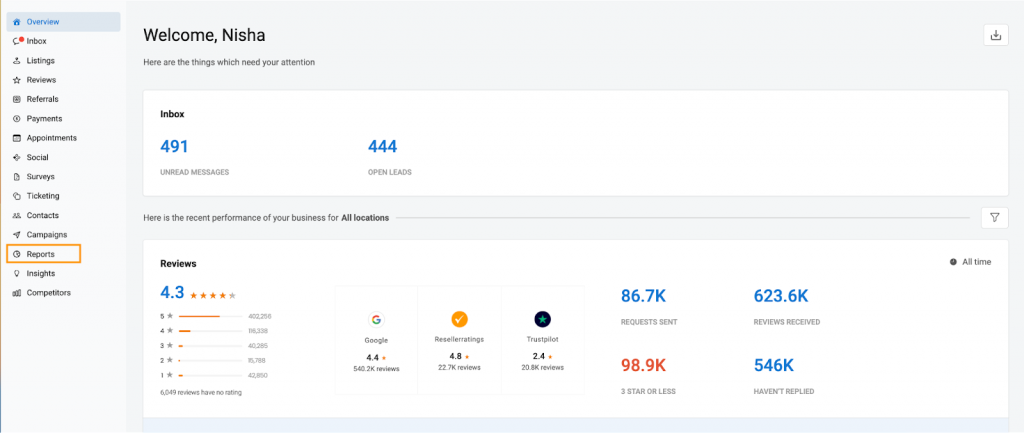
I remember a franchise owner who dreaded checking reviews—one-star comments slipped past them, and unhappy customers went unanswered. With Birdeye, everything landed in one dashboard.
Their team could reply faster, and AI even drafted polished responses when volume spiked. Within a quarter, their average rating climbed, and they stopped losing customers to silence.
Best for: Multi-location review management
What you will like:
- Collect and manage reviews across 200+ sites
- AI-powered suggested replies for faster turnaround
- Messaging and feedback surveys in one place
- Handy mobile app for on-the-go management
What you may not like:
- Pricing can be steep for smaller businesses
- Onboarding takes some adjustment for new teams
Price: Custom pricing
User Rating: 4.7/5 (G2 & Capterra)
User Review: “We’ve really enjoyed using Birdeye. One challenge we’ve noticed is that when a customer edits their review, it doesn’t always prompt or flag that the review has changed. It would be great if the system notified us consistently so we don’t miss important updates from our guests. Other than that, the experience has been very positive.” – Alex I., Marketing Supervisor
Digital Experience Platforms:
Digital Experience Platforms help deliver that by unifying content, personalization, and analytics into one ecosystem. They give you the tools to design, manage, and optimize every touchpoint, so customers feel like your brand “just gets it,” no matter where they meet you.
18. Adobe Experience Manager
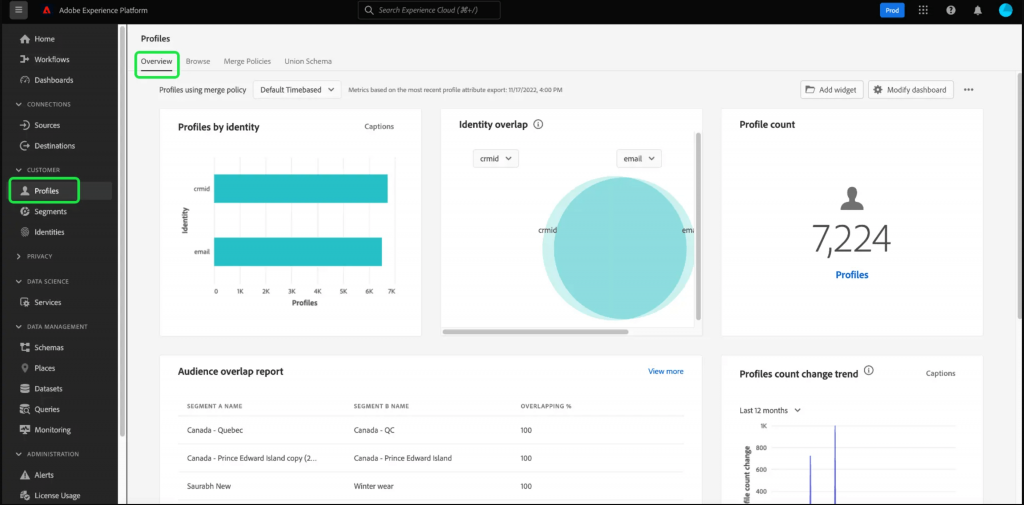
I once heard from a digital lead who said managing content across their site, app, and campaigns felt like spinning plates. Adobe Experience Manager changed that. It is primarily a content management platform but has several useful AI-driven customer experience tools.
These include automated insights into feedback and sentiment, and automated segmentation of your audiences according to their behavior and history. It also contains the tools to automate content delivery and support recommendations based on those insights.
Best for: Feedback and sentiment analysis.
Pros:
- The survey add-on lets users create web apps to design and manage online forms and surveys.
- Lets you store collected insights in a database or local variables.
- Helps filter responses.
- Shows results in real-time.
- Offers dedicated charts to help analyze the data.
- Lets users add images, videos, hyperlinks, captcha, etc., in the forms.
- Integrates with other Adobe products, Salesforce, and Livefyre.
Cons:
- Implementation can be tricky.
Pricing: Available on request.
User Rating: 4.2/5 (G2)User Review: “While Adobe Experience Manager is powerful, it comes with a steep learning curve that can be overwhelming for new users, particularly those without a technical background. The platform’s complexity often requires a significant investment of time in training and onboarding before team members become productive.”– Abby B., Pixel Wrangler (G2)
19. OpenText Experience Cloud
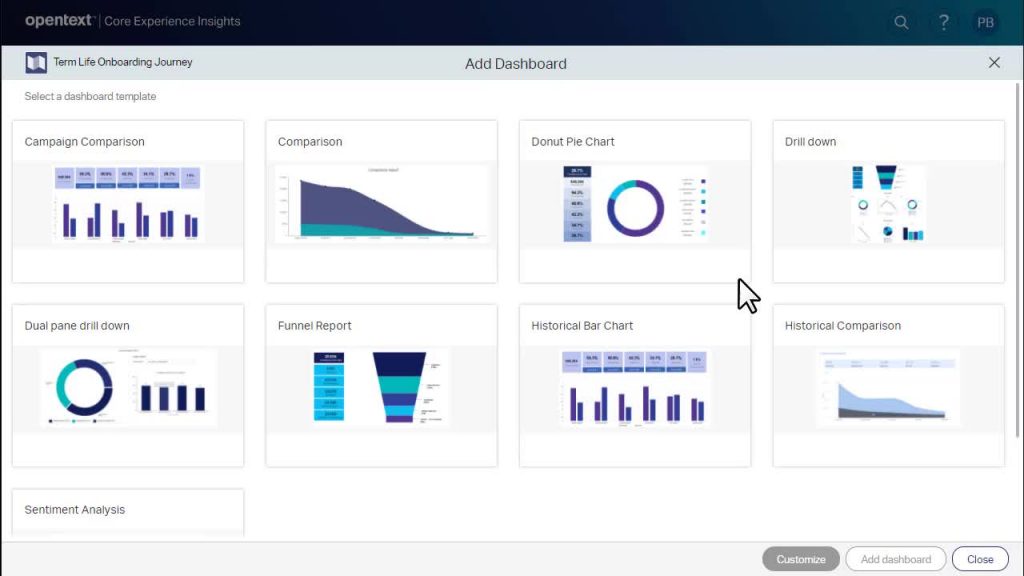
I talked to a customer service head who said their agents wasted hours hunting for the right content during calls. After moving to OpenText Experience Cloud, all customer-related content was in one place. It combines contact center, content management, and analytics tools into one platform to offer unique digital customer experiences. The tool enables advanced AI assistance for support agents, allowing for personalized recommendations based on individual user insights.
Best for: Content management and customer inquiry.
Pros:
- Helps respond quickly to customer needs and improve customer satisfaction KPIs.
- Shortens resolution times with real-time access to customer-related content.
- Eliminates information silos with simplified system architecture.
- Leverages customer information during interactions to increase loyalty and revenue.
- Gives your agents secure and unified access to improve their productivity.
Cons:
- Inconsistent roadmap.
- Requires an early-stage tutorial for new users.
Pricing: Available on request.
User Rating: 4.4/5 (Gartner)
User Review: “The search capability (it’s a great selling feature for training users), sharing assets internally using a link and rights management are important features for us and they work really well. It’s really complicated to upgrade and, since we have to outsource the work, doing an upgrade has a major impact on our budget and can be difficult for us to afford.” – Chief Knowledge Officer (Gartner)
Customer Analytics & Insights:
By turning raw feedback into clear action, these tools give you the confidence to make changes that actually move the needle:
20. SAS Customer Intelligence 360
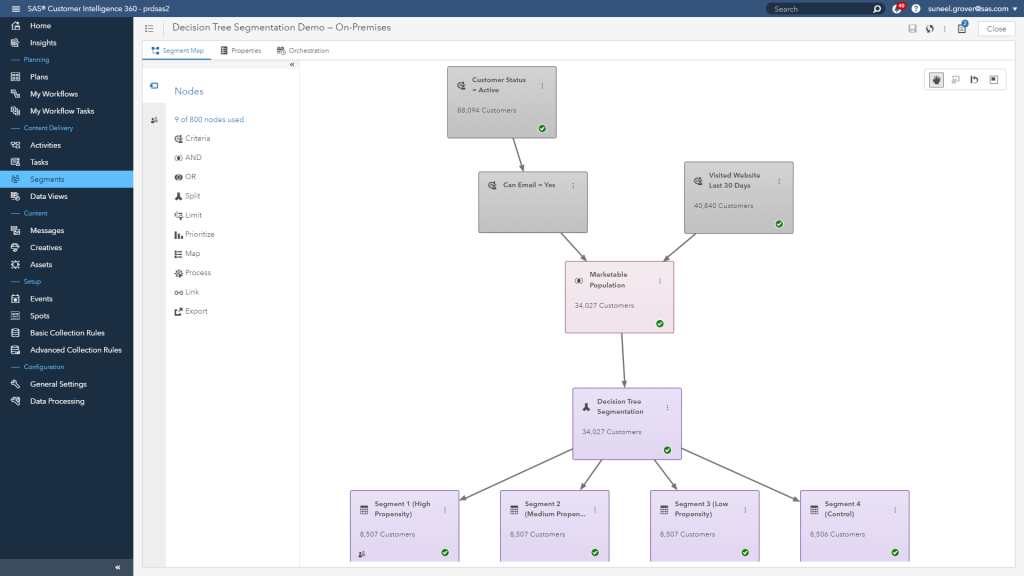
I spoke with a marketing team that admitted they were guessing at which parts of their funnel actually worked. After adopting SAS Customer Intelligence 360, they could finally map the entire journey visually.
Visual maps and dashboards bring your customer journey to life, revealing insights that might otherwise stay hidden. With SAS Customer Intelligence 360, you can confidently make data-driven decisions, creating experiences that truly resonate with your customers.
Best for: Automated customer journey testing and optimization.
Pros:
- Helps automate and streamline marketing planning activities to boost accountability.
- Supports creating personalized customer journeys that enhance response rate and lead generation.
- Comes with advanced AI capabilities that help decipher customer feedback and act on it.
- Facilitates in-calendar management and data contextualization.
- Offers high-level reporting.
- Shows information based on the criteria selected
Cons:
- Crashes sometimes.
- Not enough documentation and resources.
Pricing: Custom pricing
User Rating: 4.3/5 (G2)
User Review: “The best part is the integration of AI-driven decisioning with campaign execution. One downside is the learning curve—SAS CI 360 is a powerful tool, but it can be complex for new users without a background in analytics or marketing automation.” – Daniel S., Business Consultant (G2)
User Experience & Testing:
From prototype testing to post-launch feedback, these platforms help you catch issues early, fix them fast, and deliver experiences that feel effortless:
21. UseTesting (Formerly UserZoom)
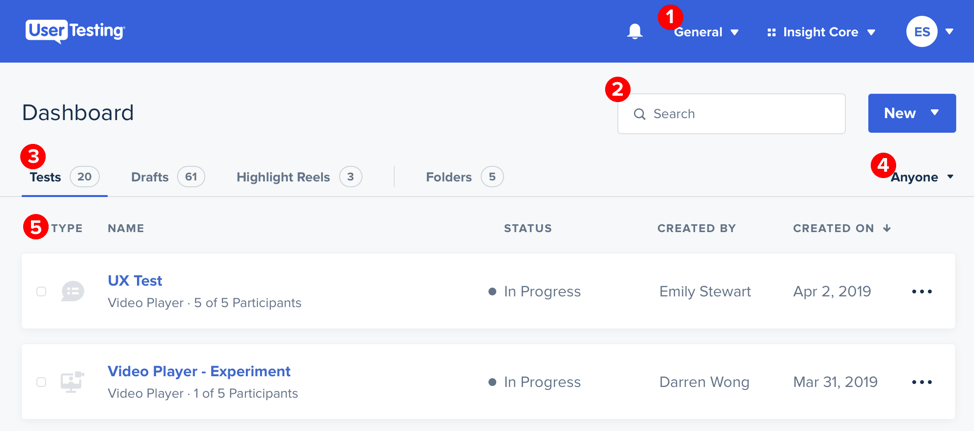
I once heard from a product lead who said, “We only learn about UX issues after launch—and by then, it’s expensive to fix.” After switching to UserTesting, they started running tests on prototypes and wireframes before code was even written. From early concept validation to post-launch optimization, UserZoom provides a toolkit for understanding user behavior, identifying pain points, and uncovering opportunities for improvement.
Best for: Usability testing, feedback collection, and analysis.
Pros:
- Offers an intuitive dashboard to compile reports on click data, user actions, unique views, heatmaps, and more.
- Helps interview users while using the app.
- Comes with analytics features like benchmarking, tree testing, surveys, and card testing.
- Supports testing wireframes, websites, mobile apps, and prototypes.
- Helps perform market research and competitor analysis.
- Offers a vast database of qualified participants.
- Provides great customer support.
- Offers an impressive range of tests to choose from.
Cons:
- No multi-language support
- Limited customization
Pricing: Available on request.
User Rating: 4.5/5 (G2)User Review: “While UserTesting is a valuable tool for UX research, some users have reported several drawbacks. These include high costs, particularly for smaller teams or startups, and the potential for overwhelming data volume without advanced analysis tools to distill key insights.”– Sameer S., Assistant Manager Human Resources
My Top 3 Choices
The best fit of customer experience management software will always depend on your unique business needs and budget. But based on my experience, here are my top three recommendations:
Option A: Qualaroo
If you genuinely want to understand what your customers are thinking at the moment, Qualaroo is your best bet. Its “Nudge™” feature is like having a friendly conversation with your users right when they interact with your site or app. You get real-time feedback on specific pages, features, and even during checkout. Plus, it’s got AI-powered analysis to help you quickly make sense of all that data.
Option B: SAS Customer Intelligence 360
This one’s for the data-driven marketers out there. It’s got all the bells and whistles you need to gather customer data from everywhere, visualize their journeys, and use that information to create hyper-personalized campaigns. In my view, it’s like your command center for turning customer insights into marketing magic. However, its extensive feature set can come with a steeper learning curve.
Option C: Adobe Experience Manager
If you’re all about creating those seamless, omnichannel experiences, I believe Adobe Experience Manager is a powerhouse. It lets you manage content, personalize interactions, and build a digital experience tailored to every customer. While incredibly powerful, it can also be a significant investment for smaller businesses.
How I Chose (and How You Should Too)
Most teams fail at CXM not because they pick a “bad” tool but because they pick the wrong tool for their stage, goals, or budget. To save you from that mistake, here’s a step-by-step guide I wish someone had handed me when I started.
1. Define Your CX Goals: Ask, “What problem am I solving first?”
- Reduce churn? → Look at survey + feedback tools.
- Improve support response time? → Prioritize help desk or chat platforms.
- Boost engagement or conversions? → Start with retargeting and CRM tools.
2. Get Clear on Budget
- <$100/mo → Start with lean, SMB-friendly tools (Qualaroo’s forever-free plan makes it easy to start testing nudges and surveys without worrying about cost.)
- $100–$500/mo → Layer in automations, CRM integrations, and analytics.
- Enterprise → Expect custom pricing, but negotiate ROI guarantees in contracts.
For example, if your immediate goal is capturing on-site behavioral feedback, a lightweight tool like Qualaroo helps you do it without heavy setup.
3. Check Integration Compatibility
Before you sign anything, ask:
- Does it integrate with your CRM (HubSpot, Salesforce)?
- Can it plug into your support tools (Zendesk, ProProfs Help Desk)?
- Is there API access for future-proofing?
4. Evaluate Ease of Adoption
Ask yourself, “How fast can my team actually start using this?”
- Look for intuitive dashboards and mobile compatibility.
- Consider staff training—does the vendor offer onboarding support?
- Pilot test with a small team before rolling out org-wide.
5. Validate with Reviews & Case Studies
Don’t just trust vendor promises.
- Cross-check G2 and Capterra reviews.
- Look for recurring pros/cons in reviews (e.g., Zendesk = powerful but complex, Hiver = simple but limited to Gmail).
- Ask vendors for case studies in your industry.
6. Measure ROI from Day One
- Track baseline metrics (churn, CSAT, NPS, ticket volume).
- Compare after 30–90 days of usage.
- Double down on what’s working, phase out what’s not.
Quick Checklist Before You Buy
- I know my #1 CX goal (reduce churn, improve support, boost conversions).
- The tool fits my budget today—and can scale tomorrow.
- It integrates seamlessly with my existing stack.
- My team can adopt it without months of training.
- Reviews from G2 & Capterra back up the vendor’s claims.
- I have a clear ROI metric to track in the first 90 days.
FREE. All Features. FOREVER!
Try our Forever FREE account with all premium features!
Features to Look for in Customer Experience Management Solutions
Choosing the right customer experience management solution is crucial for creating those memorable experiences that foster loyalty and growth. Here are five essential features to prioritize:
1. Data-Driven Decision Making: Don’t just collect numbers; transform them into action! Your CXM solution should offer AI-driven insights and actionable recommendations, helping you pinpoint improvement areas and make data-powered decisions to enhance the customer experience.
2. Unified Customer Profiles: In today’s multi-channel world, customers interact with your brand across various platforms. Your CXM solution should seamlessly capture feedback and data from all touchpoints, creating a holistic view of each customer and their journey.
3. Real-Time Visibility: The customer experience landscape moves fast. Ensure your CXM solution provides real-time dashboards and visualizations, allowing you to keep a finger on the pulse of customer sentiment and act quickly to address any issues.
4. Journey Mapping & Optimization: Understand your customers’ path from discovery to loyalty. Your CXM solution should enable you to track and analyze customer behavior at each stage, uncovering opportunities to personalize interactions and optimize the entire journey.
Budget & ROI: Making Customer Experience Management Software Pay for Itself
The #1 reason CXM projects stall? Budget pushback. The truth is, you don’t need enterprise pricing to see returns—you just need a plan that shows ROI quickly. Here’s how to do it:
1. Set a Budget Range (Not a Blind Number)
- SMBs: Allocate $50–$200/month for surveys, chat, and a knowledge base.
- Mid-market: Expect $200–$500/month as you add integrations and reporting.
- Enterprise: Go custom, but tie pricing to contractually agreed KPIs.
Action: Decide your monthly ceiling now. Tools like Qualaroo even offer a forever-free plan to help you test before you scale.
2. Identify Quick-Return Metrics
Forget vanity numbers—focus on levers that impact dollars:
- Churn rate (% of customers leaving)
- Ticket volume (and cost per ticket)
- Conversion rate (before/after surveys/nudges)
- Customer lifetime value (CLV)
Action: Record today’s baseline for each metric.
3. Launch One Pilot Use Case
- Add an exit-intent survey to catch why visitors leave.
- Roll out a chatbot to reduce repetitive support queries.
- Trigger in-app nudges to increase feature adoption.
Action: Start with one quick-win feature that ties directly to your chosen ROI metric.
4. Prove ROI in 90 Days
Compare your baseline vs. after 90 days:
- A 5% reduction in churn = massive CLV gains.
- A 20% drop in tickets = direct cost savings.
- A 10% boost in conversions = measurable revenue.
Action: Present these numbers to leadership or your team to justify scaling.
5. Scale with Confidence
Once ROI is visible, you have the data to budget for integrations, automation, and advanced analytics without resistance.
Action: Use your 90-day ROI story to unlock more budget for growth.
How to Implement Customer Experience Management Software Without Losing Steam
Buying customer experience management software is easy. Getting it up and running—and actually adopted—is where most customer experience management companies stumble. I’ve seen teams overcomplicate rollouts and lose momentum before the tool ever shows value. Here’s a practical way to think about CXM implementation:
| Phase | Timeline | Key Actions | What You Achieve |
|---|---|---|---|
| Quick Wins | 0–30 Days | - Add an on-site survey- Launch a chatbot for FAQs- Roll out a shared inbox | Immediate ROI, reduced friction, early team adoption |
| Medium-Term Rollouts | 30–90 Days | - Integrate with CRM, help desk, analytics- Automate reporting for leadership- Train frontline teams and gather internal feedback | Streamlined workflows, leadership visibility, stronger adoption |
| Long-Term Strategy | 90+ Days | - Layer predictive analytics- Launch AI-driven personalization- Build journey maps and CX dashboards- Segment customers and predict churn | Proactive growth engine: smarter decisions, reduced churn, company-wide CX visibility |
Technical Requirements to Keep in Mind:
- Seamless integrations with your CRM, ticketing, and analytics tools
- Scalable architecture (cloud-based for most businesses)
- Mobile compatibility so customers can engage anywhere
- Strong security and compliance (GDPR, HIPAA if applicable)
- Flexible reporting to tie CX to business KPIs
The goal isn’t to launch everything at once—it’s to build momentum with quick wins, prove value, and then expand into the deeper layers of CXM.
Importance of CX Management Software
Customer experience management tools are essential for creating a customer-centric culture regardless of your industry. There are plenty of reasons why you need one in your organization:
Uncover Customers’ Pain Points & Expectations
The most crucial function of a customer experience management software is understanding user behavior. It allows you to hear directly from your customers and address their grievances and delights. It also enables you to know what is and isn’t working for them so you can make well-informed decisions.
You can also quantify their experiences using various metrics, such as the net promoter score (NPS), customer satisfaction score (CSAT), customer effort score (CES), and usability test score.
Turn those experiences into measurable numbers to compare past and present scores and see if your optimization efforts were fruitful.
Optimize Your Website, Product, or App
Once you get the points of friction that hinder a seamless experience, you can use the data from the customer experience management software, such as usability test results, customer insights from surveys, and feedback from support tickets, to optimize your website, app, or product.
Today, many customer experience management software also provide advanced techniques, such as AI-based sentiment analysis, text analytics, centralized message center, and others, to reduce the time needed to mine the data.
Provide Smooth Customer Support & Assistance
As mentioned in the previous sections, customer experience management software also let you place help aids on your website or product. These involve live chat widgets, help centers, FAQ sections, ticket assistance, and forums. It’s also a good idea to set up call routing if your customers prefer to speak to someone over the phone. This could help you manage large call volumes while keeping customer support relatively smooth.
This way, inbound calls to your call center solution can be routed to another location when they’re after office hours. Remember that when it comes to customer support, even a single negative experience can cause you to lose customers, so it’s worth investing in making your support as smooth and professional as possible.
This is slightly obvious but crucial nonetheless: Mapping customer experience boosts user engagement and conversions. When you know what customers are looking for and how they interact with your website, you can design optimal solutions and process flows to create a streamlined experience.
For example, adding a one-click checkout button to your mobile app or a 360-degree product view on the product pages. And with increased engagement comes higher chances of conversions.
Now that you have an idea of how customer experience management software help let’s have a look at the top tools in the market so that you can choose the one that’s best for your business.
FREE. All Features. FOREVER!
Try our Forever FREE account with all premium features!
Bring Your A-Game With the Right Customer Experience Tools
Picking the right customer experience management software is critical. Different customer experience management software offer different insights, so one tool will unlikely do it all. A mix of tools might be your best bet.
For example, Qualaroo is excellent for quick surveys and observing customer behavior on your site. UserTesting allows for in-depth usability testing and user experience research, while ProProfs Live Chat lets you talk to customers directly when they need help.
The right combination of CXM tools helps you spot problems and fix them quickly, allowing you to create the experiences your customers want.
Frequently Asked Questions
What is the Difference Between CXM and CRM?
While often used interchangeably, Customer Relationship Management (CRM) and Customer Experience (CX) are two distinct yet intertwined aspects of building strong customer relationships.
Customer Relationship Management (CRM): Consider this your centralized repository for customer data. It's where you meticulously track every interaction - sales calls, support tickets, email exchanges - transforming those touchpoints into valuable insights.
Customer Experience Management (CXM): This encompasses how your customers perceive your brand, products, and services. It delves into their thoughts, emotions, and overall journey as they interact with your company. A positive and memorable CX is the cornerstone of cultivating customer loyalty and advocacy.
What are the 5 C's of customer experience?
The 5 C’s are clarity, consistency, convenience, connection, and customization. Together, they ensure customers understand your brand, enjoy a seamless journey, feel emotionally engaged, and receive personalized experiences that build loyalty.
What are the types of CXM tools?
CXM tools include feedback and survey platforms, knowledge bases, CRMs, help desks, digital experience platforms, and analytics tools. Each type targets different stages of the customer journey, from collecting insights to delivering personalized, scalable experiences.
FREE. All Features. FOREVER!
Try our Forever FREE account with all premium features!

 We'd love your feedback!
We'd love your feedback! Thanks for your feedback!
Thanks for your feedback!


